



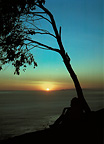







The Friedman Archives Newsletter
July 2009
In this issue:
Antelope Canyon Images
A few weeks ago I headed up to photograph Antelope Canyon, a slot canyon in Navajo Nation, Arizona (a little northeast of the Grand Canyon). If you've never experienced these (or caves like it in Zion National Park in Utah), you may wish to consider doing so. Like the Grand Canyon nearby, these sandstone canyons were carved by thousands of years of running water. Photos cannot do the place justice -- the canyons are absolutely beautiful. Some of my favorite images appear below:
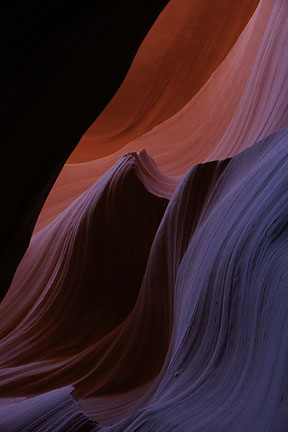 |
|
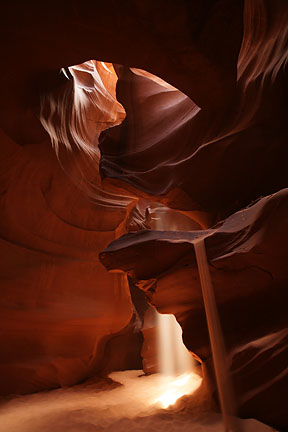 |
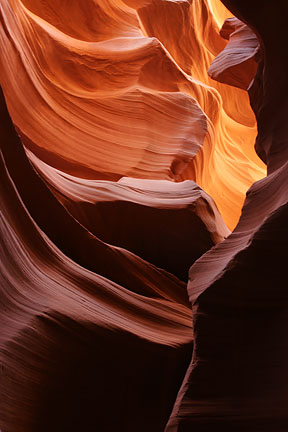 |
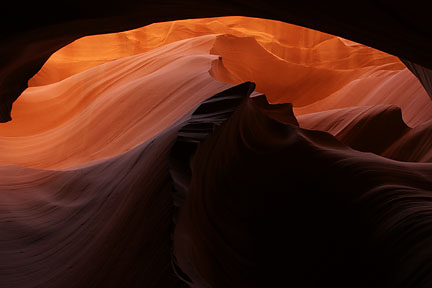 |
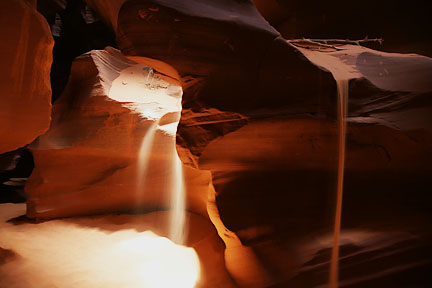 |
There were three general challenges I had to overcome in order to get shots that looked this nice:
1) Trying to take original pictures
2) Dealing with a scratched Zeiss lens (!).
3) Proper exposure (keeping your camera on AUTO will surely yield overexposed images)
Each one of these is a story in itself. :-)
1) Trying to take original pictures
Try doing a Google image search for "Antelope Canyon" and you'll see hundreds of thousands of results of images that look pretty much as nice as the images above. (It's really hard to take bad pictures here!) So while it's nice to get pictures that everyone else takes, the creative part of me (the part that's a working photographer, the part that's incentivized to take pictures that are DIFFERENT and ORIGINAL so people will license from me instead of grabbing one off the web) wanted to do better.
And so, I do what I always do before an important shoot: In addition to doing research (regarding best time to shoot, location, weather, crowds, etc.), I also took out my sketchpad and sketched out some ideas of photos I'd like to take. (It's important to pre-visualize the shots you want to take before you get there. It helps the creative process AND helps you avoid photographer's block when you're on the scene. Even if you end up not using your ideas, it's always good to have a plan and it really helps you to think creatively.) Below are two of my favorites, which have a similar theme:
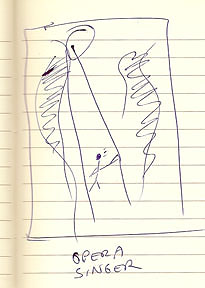
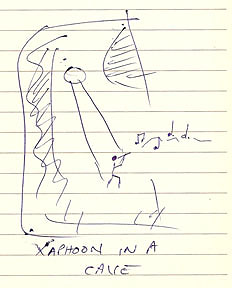
| The first was my
attempt at a joke: millions of people have taken photos of the
canyons, but I'll bet none of them tried to use the beam of light
to illuminate an opera singer posed at the bottom. :-) A
similar theme comprised the second shot, of a lone Xaphoon player
in a picturesque cave. (This could be used in a poster to
help sell the instrument, with room for writing in the top half of
the composition. I can write off my trip twice! :-) )
When I finally got there I realized that I couldn't implement either of these ideas. The beams of light that you see in these images only lasted a few seconds. And they don't appear naturally -- in order to see them you must take a fistful of dirt and throw it into the air. The light hits the dust particles, some of which divert the light to the camera. And the dust settles within a few seconds. Without the dust or smoke in the air, your eye would never see the beam of light entering the cave. Steven Speilberg is famous for having lots of smoke on his sets in order to achieve this "beam of light" effect in E.T. and many an Indiana Jones film. A plethora of other tourists in the vicinity also prevented me from doing anything that would monopolize the view for more than a few seconds. So, although it's good to come prepared with some ideas, sometimes you have to abandon them and just do what you can. I did try a variant of the Xaphoon player idea, though, which you can see to the right. (I'm starting a trend by using balding, middle-aged models to sell products. Do you think it will catch on? :-) ) |
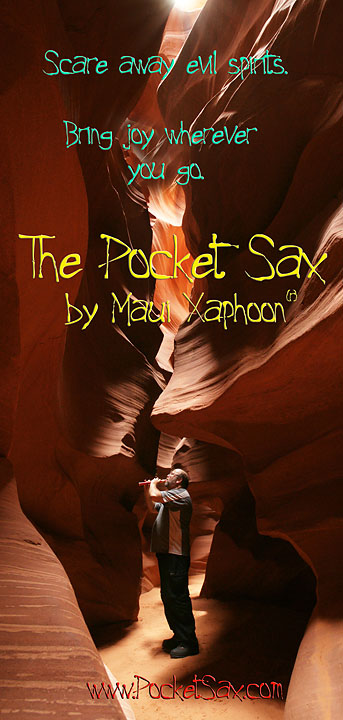 |
2) Dealing with a scratched Zeiss lens
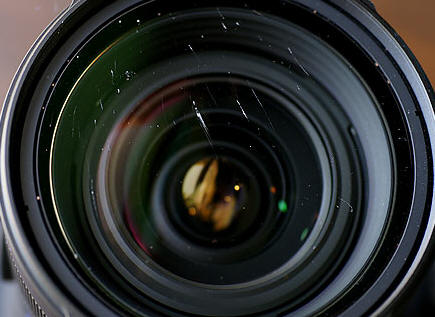 All of my life I have eschewed UV or
skylight filters in front of my lens, because I felt that they
could only degrade image quality, and besides, "I don't need no
stinkin' filter!". And up until now I've never had an
incident which caused me to re-think that
strategy.
All of my life I have eschewed UV or
skylight filters in front of my lens, because I felt that they
could only degrade image quality, and besides, "I don't need no
stinkin' filter!". And up until now I've never had an
incident which caused me to re-think that
strategy.
A mere fifteen minutes into my day-long photo shoot, my A900 and CZ 24-70 lens fell off the tripod and onto the rocky, sandy ground. What resulted was a muffed up card door on the A900 (plastic absorbs impacts nicely!) and some pretty significant scratches on the front element of the lens.
I panicked for about minute, until I realized that under these particular shooting conditions the scratches would probably never show on the image. A few quick test shots confirmed this.
Why would this be? A confluence of reasons. A blemish such as a scratch or a hair will only be in sharp focus when it's either on the surface of the sensor or on the subject your lens' optics are focused on. If it's anywhere between these two points it will be out-of-focus, and this includes the surface of the lens. I'm speaking in generalities, of course -- much depends upon your lens, the thickness of the defect and the f/stop you're using -- in the worst case you might see a darkening in one area. In my case they were invisible. And as long as I was shooting indoors with no light direct light shining onto the front surface of the lens and an aperture of less than f/8 or so, this scratch would not ruin my pictures. I was safe.
But what if there was direct light shining onto the front surface? Then it would look like the left shot in the "Before and after" shots below. (I created the right shot by simply blocking the light hitting the front surface with my hand - essentially acting like a human lens shade.) The scratches act to disperse the direct light which falls upon it. Thank goodness I hadn't dropped my lens the morning of an outdoor shoot!


With light hitting front surface No light on front surface.
The lens is in for repair as I write this. And Sony has made some improvements in their warranty repair process. Rather than having me pay for shipping into their repair facility in Laredo, TX, Sony gave me the option of taking the lens to a nearby Sony Style retail store where it will be shipped for free, or giving me a discount on a UPS shipping label (USD $7!). A nice improvement over when I had to send in my A700 for service back in 2007 (which I documented here).
3) Exposure Issues
| This is just one of
many, many difficult situations where your exposure meter is just
not going to give you exceptional results on its own. Oh,
sure, it'll make your images look the equivalent of 18% grey (like
the image on the left), but if you want to emphasize the light and
shadow it's best to use something other than automatic exposure
mode.
In the old days (like when shooting film), that would have entailed using a spot meter and measuring the lightest and darkest areas of your composition, and then deciding how you'd like each brightness area to be rendered in your final image and set the exposure accordingly. (If you're shooting B&W film, you could also custom develop that particular negative to make sure that both the brightest and darkest areas would all show detail. This was the essence of the Zone system, where you could expand or contract the dynamic range of your negative to match the dynamic range of the scene.) |
 |
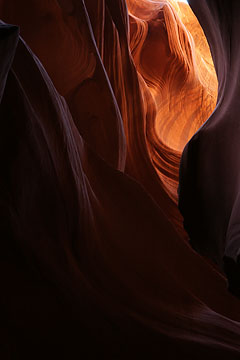 |
But today we have the instant feedback of digital, and the very easiest thing to do is what I told my wife Carol (a non-photographer) as I gave her my backup A700 camera to shoot with. I said, "Here's how to use the exposure compensation control. Take a picture, look at it, and then change the setting and shoot again until the picture looks like you want it to look."
That was it! Her images came out great. (One of which was included in the gallery near the top of this page.)
So, a lesson for beginners: If you find your camera's seemingly infinite settings to be intimidating, concentrate first on using just the exposure compensation control (so it looks like the image you've pre-visualized in your mind beforehand). This, more than any other single setting, can have the greatest impact on the artistic quality of your images.
One final note: If you ever find yourself going to a destination where you say to yourself, "I wish I had a [certain expensive lens or an A900 body] but I just can't afford to buy one!", then don't forget you can rent what you need just for the duration of the trip. For this trip I rented the new Zeiss 16-35 f/2.8 lens from Alpha Lens Rental (www.AlphaLensRental.com), who also can rent you an A900 body as well. (And tell them that Gary Friedman sent you!) (And yes, that lens was returned unscratched.)
UPDATE: In the first 24 hours after publishing this newsletter I received a lot of emails asking me "So what is your new philosophy on UV filters?" My answer is "I'm now much more prone to consider using them than before!". (Okay, the real answer is "I will use them on all of my high-end lenses from now on". I just have to be mindful of the additional internal reflections that they can cause under certain conditions, and remove it at those times.)
E-Books now available in Español!
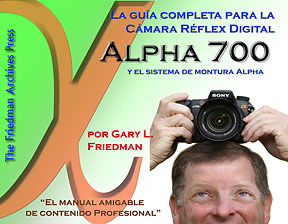 It's been said that the most difficult
thing to translate is musical theatre, because the translator must
have command not only of the subtleties of multiple languages, but
the rhyme and meter and poetic flavor of the lyrics must also fit
into the original musical score as well.
It's been said that the most difficult
thing to translate is musical theatre, because the translator must
have command not only of the subtleties of multiple languages, but
the rhyme and meter and poetic flavor of the lyrics must also fit
into the original musical score as well.
If that's true, then the 2nd most difficult thing to translate must be technical books that explain things clearly, have a personality and a sense of humor. And that's probably why none of my books have been translated into other languages until now. :-)
For the past few months I have been working with just such a talented person - a person who is an outstanding photographer in his own right and an outstanding translator as well - to translate my books into Spanish. Mr. Francesc Garcia lives in Barcelona, Spain, is active in the SonyAlpha.es discussion forum, and most recently was one of five co-founders of a photographic association where amateur photographers can explore and expand their potential (www.afes.cat). Like me, he has a background in IT, business, and sales, but unlike me he appears to have a wealth of spare time on his hands. :-)
Currently the books for the Sony A700, A300/A350, Advanced Topics 1, 2, and "25 Ways to 'Wow!'" have been translated and links to them can be found on the ebooks page, with the A200, A100, and A900 books to follow. The newsletters are also being translated slowly (like the one you're reading now). The books have been well-received so far, as word continues to spread organically throughout the internet. It is an honor and a privilege to be working with Francesc (and he seems to be enjoying himself too!).
These new products have forced me to upgrade to a new web-based shopping cart in order to handle orders in different native languages. There were many criteria I had to make sure that the buying experience was clear and easy and that the delivery mechanism was superior to my old cart (which did not send download links in emails). Now you get download links in confirmation emails and on the confirmation page in case the email never gets to you (hey, it happens!). I've been working on this for a few months now, and starting next month I'll be selling all of my titles - in both English and Spanish - via this new shopping cart.
Seminar Updates
There are four more seminars planned for the rest of this year:
| Nova Scotia, Canada August 8-9, 2009 | Click here to sign up! |
| Nashville, TN September 12-13, 2009 | Click here to sign up! |
| Manhattan, NY October 17-18, 2009 | Click here to sign up! |
| Southern California November 14-15, 2009 | Click here to sign up! |
In November the seminars return to Southern California for a 3rd time (the fact that I live here may have something to do with that). This time it's in the San Fernando Valley, about a mile from where I and Michael Jackson grew up.
For those of you who are new to the newsletter, the Friedman Archives Seminars are a traveling weekend event which serve as an enjoyable way to jump-start your journey into serious photography. If you've ever felt a little overwhelmed about all the settings and variables your camera offers and are looking for a fast-paced and enjoyable way to help sort it all out, then these seminars are for you. Not only are the essentials such as light and composition covered, but also the technical stuff in a way that is intuitive and designed for long-term memory retention of what you learned. Sign up today, or register your city at the bottom of this page!
Until next time...
Yours Truly,
Gary Friedman
Subscribe to this Newsletter Next Newsletter - September, 2009
Previous Newsletter - May, 2009 Newsletters Main Page
Back to the Friedman Archives Home page